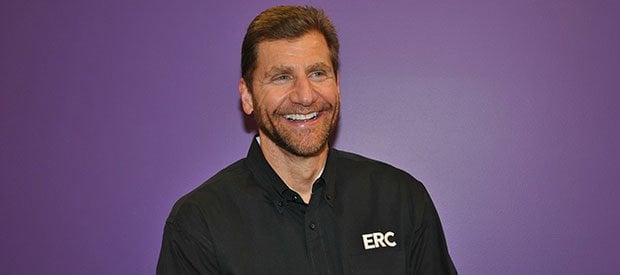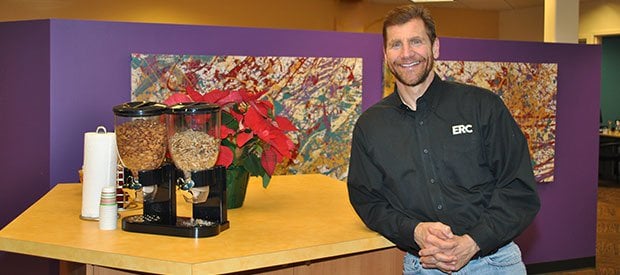In a 2014 interview, Pat discusses the dynamics of work, family, and the leadership role in today’s business world. The following pages include Pat’s responses to many of the HR trends he sees emerging, as well as his comments about what the New Year has in store.
If you could snap your fingers & instantly change 3 typical company policies, what would they be?
“That’s an easy one! The three I would immediately change in the workplace are…
- Eliminate probationary periods
- Refine bereavement leave policies
- Refine the traditional use-it-or-lose-it PTO
“These are the first that come to mind. These types of polices were designed decades ago and really do not play well for today’s top performing employees,” explains Pat.
If eliminating or refining these policies makes you queasy, you may want to take a close look at whom you’re employing. Top talent needs the support of a flexible and caring work environment to thrive.
“These are the kind of policies needed for people in your company you simply do not trust. Keeping these types of workplace practices in place, is like the tail wagging the dog. Populate your company with people who perform and whom you trust. Then the need for these programs becomes non-existent,” Pat states.
How important is it to provide community service opportunities for employees?
“There is no doubt that today’s top performers want to make a difference in the community.” Pat notes that the challenge for company leaders is to facilitate and/or empower such opportunities. Whether this happens as a company-sponsored charity event, or individual employees being given time off work to volunteer, or some solution in-between… Pat encourages leadership to have this important conversation.
For employers that feel a little unsure of where to begin, or are nervous about giving staff time off, Pat suggests starting small. If your company is interested in starting an outreach initiative from within, you can test the waters with a ‘random acts of kindness’ program. If empowering individuals to make a difference sounds more up-your-alley, Pat recommends talking with your top people to hear what ideas inspire them.
Pat believes that everyone has the ability to change the world daily. He comments that once people realize this, and they take actions to positively impact someone’s life… a ripple effect occurs and causes recurring positive change with others.
At ERC, Pat continually reinforces that ERC employees ‘move the needle’ every day. Staff see it and experience it with our customers and their organizations.
“The neatest part about our jobs at ERC is that because of our team’s work, someone out there is paid fairly, is being treated better, gets a promotion and/or has enhanced skill sets… and the list keeps going… that is so cool!” Pat comments.
In addition to ERC team members’ daily work, the organization embarks on a different community initiative each year. For instance, each week in 2013, a $50 bill was handed to a randomly-picked staff member, who in turn had one week to recognize WOW customer service customer service outside of ERC. As the $50 bills were passed along throughout the year, staff shared their experiences and touching stories with each other. The stories were really inspiring, the staff had a blast, and the initiative was successful.
It seems like today’s workforce is becoming 24/7 due to technology. What are your thoughts on this and how do you see this impacting work/life balance initiatives?
“I think it really depends on the individual – if you want to be a slave to work you can… if you want to have a life outside of work, you can do that instead. There is no doubt that due to technology, employees can stay connected to work anytime of the day and night. Ironically, because of technology, employees can also customize their lifestyles around work and in effect, work non-traditional hours around family considerations,” Pat comments.
In more and more companies, today’s work week is anything but traditional. People are customizing their life; they’re determining what’s important to them by prioritizing, and then building a life around them that makes sense. Pat believes that in the workforce, this customization will be driven more from the individual than from the workplace or HR.
While there will certainly be some folks that elect to be 24/7 with their employer, Pat has created an environment at ERC where staff and their families come first and business second. “I do not want anyone working at ERC that values work over their family. We provide an environment at ERC where employees can be home for dinner and not work weekends or evenings.
Top performers appreciate this flexibility, are devoted to their families and in turn, truly appreciate the flexibility we provide in our company. And, make no mistake, this flexibility does not inhibit great customer service. Actually, the opposite occurs. I have said it for years, and I will continue to stand by our staff – they will out-service anyone on earth anytime. That’s what happens when you hire and keep the best people,” Pat states.
“I tell our staff all the time that you will never have a second chance to attend your child’s day care or school program. If you don’t go because of work, I do not want you employed at ERC. And neither does your child,” Pat added.
There will always be some traditional workplaces with a traditional work week; however, Pat feels that these workplaces will become the minority. Certainly, there will still be some employers that believe loyalty is displayed through accessibility, and employees of such organizations will have to choose if this is the culture in which they want to work.
Organizations that are truly focused on attracting & retaining top talent will, Pat believes, continue to liberate themselves from traditional thinking in terms of workplace flexibility. While it may be tougher to achieve some of the more traditional measures of success, Pat encourages organizational leaders to define success differently. He believes that with greater workplace flexibility and well-balanced employees, comes a more sustainable model with staff that show greater innovation, risk-taking , better aptitude & attitude. (And these items are, of course, a great recipe for organizational success.)
There is so much talk today about leadership. What is your take on the subject?
Pat mentioned that his views on the subject of leadership have changed significantly over the last 15 years. During that time, he really began to appreciate the importance of having the right people on the team – namely top performers. Additionally, with a traditional upbringing in HR and management, Pat believes leaders need to let go of antiquated and traditional leadership thought, and clean the slate.
He states that if you want to lead top performers, then you can throw away just about everything learned in Management 101. In Pat’s eyes, top leaders today need to:
- Genuinely care about employees & their families.
- Put family first.
- Have an attitude of continuous improvement – for themselves & their organizations.
- Expect the highest of themselves – set an example of work ethic & performance.
- Acknowledge when they’re wrong.
- Be selfless.
“There has been so much written about leadership and very little discussed about followers. If you have employees that are top performers, you do not have to manage them. You simply attempt to lead by example, be there for them when they need you, set organizational direction, and truly care about your staff. If you have the right people in place, leadership takes on a whole new meaning,” Pat states.
In hiring and retaining top talent, Pat encourages managers and executives to look less at job descriptions and position duties, and instead, focus on attitude and aptitude. If these are a fit for your organizational culture, Pat believes your employees are more likely to make themselves happy – by leading & excelling in:
- Knowing their job
- Believing in what they’re doing
- Loving what they do
What are your 2014 resolutions, and what do you think the New Year has in store for the business world?
“I simply do not make New Year’s resolutions – never have and never will,” Pat comments. While Pat has never made traditional New Year’s resolutions, he does have a daily resolve to continuously beat the previous day – the way he acts, what he does on the job, and most importantly how he is as a husband and a father. Pat views this approach as a more sustainable way for him to set and achieve goals, rather than a once-a-year exercise.
“As for business in general, who knows? I have never been an advocate of long-range planning and to some extent short-range planning. The world is complex and dynamic. To be successful, you need to remain flexible, open-minded, and be ready to change,” Pat states. Pat claims that while you can have some foresight and some visions to make best-guesses, what’s even better is to adapt and change as necessary. “The only thing we know for sure is that 2014 will be exciting, fun, and challenging at times – with some mistakes, certainly – but hopefully with many more successes,” Pat added.
How do you handle adversity?
Pat loves the challenge of adversity and the motivation it brings. He reasons that becoming stressed over a situation beyond your control is, basically, a waste of time and energy. And positive energy is precisely what you need during those difficult times – to right the wrong. So don’t waste your energy with worry; rather, Pat suggests focusing on your reaction.
The only thing you can do when something goes wrong is to react to it – in either a positive or a negative way. How you respond, Pat believes, is how you build character. And the fun, Pat says, comes from looking back and saying, “Look what we accomplished, despite _________.”
“Look… bad stuff happens… but that’s an opportunity for you as a leader to utilize your intellect, your skill sets, and your experience to build a strategy,” Pat states.
Another way that Pat approaches adversity – and the stress that often accompanies it, is through a high intensity daily exercise regime. “This is my time to get in the zone and de-stress if necessary. I have always exercised, but I took it up a notch about 6 years ago. I do a combination of P90x and the Insanity/Asylum programs. These programs, without a doubt, allow me to do a daily re-boot,” Pat comments.
Pat encourages leaders to find their own ‘reboot’. Whatever it is that helps ground you, utilize that outlet on a regular basis… and make that personal time a priority. The better you are able to lead at work, the better off your company & its employees will be as well.
What were your early influences and inspiration?
Pat says he knew fairly early on in his career that he needed to lead something… that he didn’t do well taking direction. He also has known, since childhood, that his biggest motivator is the word ‘no.’
“Whenever someone would tell me I couldn’t do something (legal, of course), or that it had never been done that way before – that was an opportunity for me to make a change. I have always felt an urgency to make positive change and I have never been satisfied with the status quo,” Pat comments.
Pat’s dad was his major influence growing up. He comments that his dad “always put our family first” – which became an important building block for balancing his own life. As a very successful banker in the 60’s and 70’s, his dad turned down several job promotions that would’ve taken him away from his family on frequent business travel. “In those days, you just did not turn down a promotion. Money was tight and if you turned a promotion down, you seldom got asked again,” Pat states.
Pat says that while this, and other sacrifices, remained unspoken while growing up… Pat remembers his dad always being there. This lesson about family commitment and priority has stuck with Pat all these years and has strongly influenced his own work-life balance. Pat proudly comments that he makes sure his son is on the bus every morning, and then gets home in time for dinner 98% of the time. With stats like that, it’s a win-win for everybody – from the folks at home to his work family here at ERC.
Get more articles like this one delivered to your inbox.
Join the thousands who receive ERC’s weekly newsletter to stay current on topics including HR news, training your employees, building a great workplace, and more.



